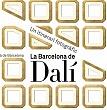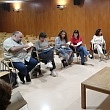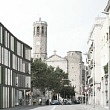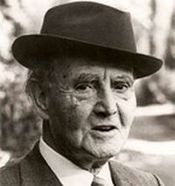Night route in the cemetery of Sarrià
06/11/202406/11/2024
 On October 24, the night route was presented at the Sarrià cemetery. Characters dressed in period costumes explained the history of Barcelona from the history of the cemetery to all those present.
On October 24, the night route was presented at the Sarrià cemetery. Characters dressed in period costumes explained the history of Barcelona from the history of the cemetery to all those present.
In addition to the niche of Ramon Miralles, mayor of Sarrià and friend of Verdaguer, to whom Vil·la Joana ceded when he was very ill, in the Cemetery of Sarrià there is the vase of J. V. Foix and the tomb of Carles Riba and Clementina Arderiu, presided over by a sculpture by Josep Clarà, among others.
FNEC: 5th literary contest J. V. Foix
24/10/202430/10/2024
 For the third consecutive year, the FNEC has held the J. V. Foix Literary Contest at the Foundation’s headquarters. On Wednesday, October 23, the awards ceremony for this 5th cerament took place. The essay category was deserted.
For the third consecutive year, the FNEC has held the J. V. Foix Literary Contest at the Foundation’s headquarters. On Wednesday, October 23, the awards ceremony for this 5th cerament took place. The essay category was deserted.
The winners in the other two categories were Joan Badia (narrative) and Clara Cuevas (poetry).
Dalí’s Barcelona. A photographic itinerary
16/10/202404/11/2024
 Inaugurated on October 3rd on the occasion of the 120th anniversary of the birth of Salvador Dalí, the Museu Diocesà de Barcelona presents an exhibition that claims the relationship of this universal artist with the city of Barcelona.
Inaugurated on October 3rd on the occasion of the 120th anniversary of the birth of Salvador Dalí, the Museu Diocesà de Barcelona presents an exhibition that claims the relationship of this universal artist with the city of Barcelona.
Curated by Ricard Mas, it shows a journey through a hundred snapshots taken by local photojournalists in spaces linked to the figure of Dalí, whose first exhibition was presented by J. V. Foix.
Days: from October 3 to December 1, 2024. Every day from 9:30 a.m. to 8:00 p.m.
Place: Museu Diocesà de Barcelona. Pla de la Seu, 7. Barcelona
Gertrudis in the central library of Igualada
07/10/202409/10/2024
 With the idea of bringing Catalan classics closer to reading clubs and sponsored by Espais Escrits, Saturday 5 October took place in the Central Library of Igualada the talk about the book Gertrudis by J. V. Foix.
With the idea of bringing Catalan classics closer to reading clubs and sponsored by Espais Escrits, Saturday 5 October took place in the Central Library of Igualada the talk about the book Gertrudis by J. V. Foix.
Organized by Lorena Jiménez and Mercè Badal, it was directed by Literature teacher Òscar Rocabert. This library was selected as part of the “Catalan classics in your reading club” project.
Exhibition Literary route in Port de la Selva
12/09/202413/09/2024
 Monday 9 September, saw the opening of the exhibition on the literary route J. V. Foix in this town on the Costa Brava, where Foix spent the summers from 1925 to 1987, the year of his death. This exhibition was designed in 2012, to commemorate the twenty-fifth anniversary of the poet’s death, with the collaboration of the Institució de les Lletres Catalanes. It goes through twelve points related to Foix’s work.
Monday 9 September, saw the opening of the exhibition on the literary route J. V. Foix in this town on the Costa Brava, where Foix spent the summers from 1925 to 1987, the year of his death. This exhibition was designed in 2012, to commemorate the twenty-fifth anniversary of the poet’s death, with the collaboration of the Institució de les Lletres Catalanes. It goes through twelve points related to Foix’s work.
The exhibition can be visited from Monday 9 to Sunday 15 September from 10am to 8pm at l’Illa, 13.
«Foix is, for me, one of the great European poets of the 20th century»
26/08/202404/09/2024
 On the occasion of the centenary of Salvat-Papasseit’s death, the magazine El temps publishes an interview with the editor Jordi Cornudella, who this year has published three key works of three Catalan poets of the 20th century: the Complete Poetry of Salvat-Papasseit, the poetry between 1917 and 1936 by J. V. Foix (Cap má no em diu adéu) and Gabriel Ferrater’s Papers sobre literatura.
On the occasion of the centenary of Salvat-Papasseit’s death, the magazine El temps publishes an interview with the editor Jordi Cornudella, who this year has published three key works of three Catalan poets of the 20th century: the Complete Poetry of Salvat-Papasseit, the poetry between 1917 and 1936 by J. V. Foix (Cap má no em diu adéu) and Gabriel Ferrater’s Papers sobre literatura.
Comparing Foix’s book from 1917 to 1936 and Salvat’s from 1917 to 1924, Salvat’s proposal is much more convincing. Although Salvat dies young, his poetry is complete poetry, says Cornudella.
You can read the full interview here.
One hundred years of surrealism: Gertrudis and KRTU
17/07/202418/12/2024
 El The Centro Andaluz de las Letras organized the cycle “Cien años del Surrealismo” to celebrate the centenary of the publication, by André Breton, of the first manifesto of this movement. International specialists analyze authors who were influenced by this trend. The activity, which began in Granada on May 16 with a dialogue between Enric Bou and Antonio Jiménez Millán, coordinator of the cycle, extends the program until the month of September.
El The Centro Andaluz de las Letras organized the cycle “Cien años del Surrealismo” to celebrate the centenary of the publication, by André Breton, of the first manifesto of this movement. International specialists analyze authors who were influenced by this trend. The activity, which began in Granada on May 16 with a dialogue between Enric Bou and Antonio Jiménez Millán, coordinator of the cycle, extends the program until the month of September.
Here you can see the poster.
The new Sarrià library will be called J. V. Foix
26/06/202426/06/2024
 On the night of June 21 it was announced that the new Sarrià library will be called J. V. Foix. After eleven days of voting, the name of the poet from Sarrià has won by 781 votes, ahead of the 426 of the translator Carme Serrallonga, the 167 of the cartoonist Núria Pompeia and the 67 of the writer Emili Teixidor.
On the night of June 21 it was announced that the new Sarrià library will be called J. V. Foix. After eleven days of voting, the name of the poet from Sarrià has won by 781 votes, ahead of the 426 of the translator Carme Serrallonga, the 167 of the cartoonist Núria Pompeia and the 67 of the writer Emili Teixidor.
The residents of Sarrià have understood the universal relevance of Foix and that the writer has made the neighborhood lasting through his work.
Sarrià is honored by Foix’s work, and has been honored by giving his name to the library.
Act in favor of the name of J. V. Foix for the library of Sarrià
19/06/202405/07/2024
 On Thursday 13 June we organized, with the help of the neighborhood, an event in Plaça de Sant Vicenç de Sarrià to support the name of J. V. Foix for the new library in Sarrià.
On Thursday 13 June we organized, with the help of the neighborhood, an event in Plaça de Sant Vicenç de Sarrià to support the name of J. V. Foix for the new library in Sarrià.
Margarida Trias read a statement from the Foundation and then Glòria Bordons, president of Espais Escrits, spoke. More than twenty people participated, including Lloll Bertran, Ainara Elejalde, Celdoni Fonoll, Òscar Intente, Rosa Renom, Carles Sales, the poets Anna Pantinat, Tònia Passola and Marta Pessarrodona, the poet from Sarrià Josep Ma Fulquet and the singer Ignasi Roda.
Here you can see Vicent Partal‘s closing speech.
You can see de poet’s video of the poets reciting here.
Presence of J. V. Foix
29/05/202429/05/2024
 The poet of Sarrià Josep Ma Fulquet has published an article in the digital magazine Núvol, which had previously appeared in the newspaper El Jardí de Sant Gervasi i Sarrià. According to him, the decision of the name of the future library of Sarrià is too important to leave it in the hands of a popular consultation and, instead, it must be dictated by the intellectual weight and the literary work of the figure who name the library.
The poet of Sarrià Josep Ma Fulquet has published an article in the digital magazine Núvol, which had previously appeared in the newspaper El Jardí de Sant Gervasi i Sarrià. According to him, the decision of the name of the future library of Sarrià is too important to leave it in the hands of a popular consultation and, instead, it must be dictated by the intellectual weight and the literary work of the figure who name the library.
Here you can read the article.





















